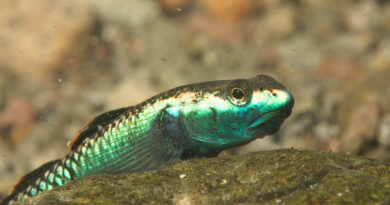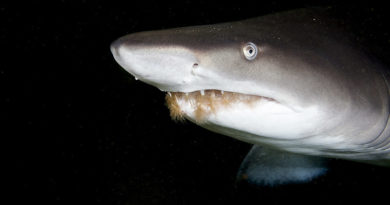All of My Sharks
In roughly two thousand dives on the coasts of all continents except South America and Antarctica, plus lots of Pacific islands not part of any continent, I have seen a lot of interesting sharks. Some of them I have had the chance to observe in great detail, while others have come out of the blue and disappeared a few seconds later, leaving me in astonishment. Some species I have photographed from multiple angles, with great success (magazine cover!), others I don’t even have a picture of (shame!).
This is All of My Love by Led Zeppelin. You can listen to it while reading about All of My Sharks. Just imagine that Robert Plant is singing “All of my sharks”.
Whale Shark. In all of my dives in the tropics, I saw a single whale shark, for about 10 seconds, while I was busy learning how to tech dive in Moalboal, Cebu. It wasn’t even an adult, but a 5 meter juvenile. But what a fish that was! It was totally unreal to observe something of that size in the middle of the blue water off the wall we were diving. By the time I had regained my composure to realize what it was, my so-far only whale shark was gone again. It was like an alien mothership flying by us. In the minutes before the whale shark appearance, I was concentrating on learning to maintain good buoyancy with 3 tanks and scouting the reef wall for the fascinating small ocean animals the ‘Pinas are so deservedly famous for. Here, a fingernail-sized crab between two corals; there, a centimeter-long goby perched on a sponge: fascinating minute marine life. Then, all of a sudden the whale shark, multiple times my size, entered my field of view. This enormous change in scale made its appearance even more dramatic.
Great Hammerhead Shark. Another shark I have seen, but not for too long. On two occasions, in Yonaguni, Japan, and at Kimud shoal near Malapascua, Philippines I spotted a few of those, but way below me, and not for too long. These animals, both in terms of their reproductive biology and their senses and brains are near the apex of shark evolution. I’d be definitely excited to see more of them!
Grey Reef Shark. A relatively common shark on tropical coral reefs, I’ve seen lots of them in Micronesia. Ah, Micronesia! One of my favorite places in the world. The beauty of the islands. Hundred year old abandoned villages in the jungle. World War II wrecks abound. And the people: super friendly, with a sense of humor very much like my own. For instance, I learned that in Yapese a mustache is called a *you can imagine* brush – just like in the Viennese dialect I grew up with. Hahah. I digress.
In Yap, Manta Ray Divers organizes a shark feed once a week. The dive operator dumps a big fish-meat ball tethered to a rope in the ocean from a dive boat, and the smell attracts sharks, to the enjoyment of the diving customers.This practice is not completely uncontroversial, since this could alter the sharks’ feeding patterns. However, this is a rather minor issue in my opinion, in contrast to the roughly 38 million sharks killed by humans each year. So, I enjoyed the spectacle, and snapped one shot of the sharks after another. Then, the chunk of fish meat used to attract the sharks came loose, and drifted towards me. “Oh, nice, now they are really coming close” I thought, and took more pictures. And they came even closer … Not that 3 mm of neoprene are a big protection against shark bites, but I was only wearing board shorts and a rash guard at that time. The fishy bait then dropped into my lap, and I did a push up on a grey reef shark to get myself out of the center of the feeding frenzy. My breathing rate did go up a bit, and I noticed that about 30 bar were missing from my tank right after the incident. No shark bit me, though, which shows that sharks are smart people, definitely smart enough to distinguish an Austrian dude from a pile of dead fish!
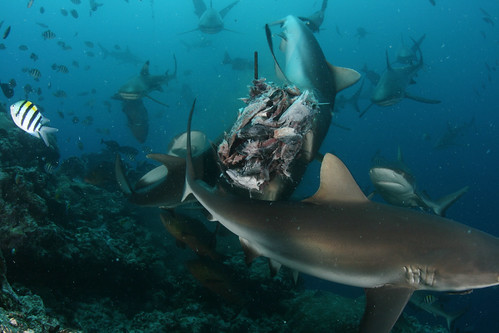
Blacktip Reef Shark. Similar to the grey reef shark, these are abundant in healthy coral reefs. I saw some nice ones in Palau. From the live-on-board I was diving I photographed the one below while on snorkel – they were aggregating behind our boat to snatch some of the leftover chicken lunch or cook had dumped into the water. What a David-Attenborough-moment, thanks to some uneaten chicken!
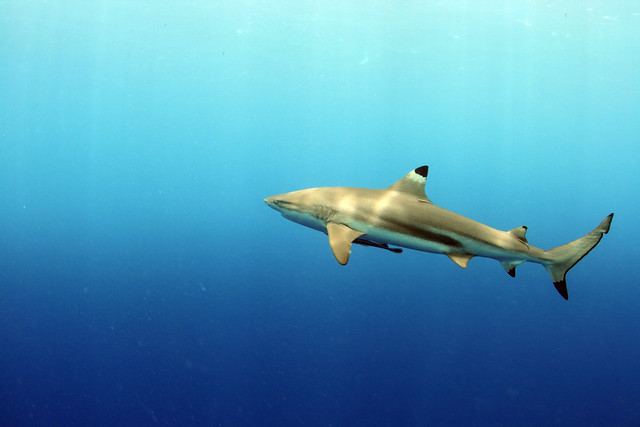
Whitetip Reef Shark. I’ve also seen my fair share of these, usually more on the bottom in cracks of coral reefs. There was a pair of juveniles in a crack of a really nice hard coral rich area in the Kreama islands near Okinawa when I was diving there a few years ago.
Tiger Shark. I’ve only seen a tiger shark once, in Palau, and from the deck of a boat. It was having lunch. The lunch was a dead pig. Now, I eat pork once in a while. But that dead pig had died a few days earlier, probably on some neighboring island, and then had gotten swept into the ocean. There it had decomposed for a few days in the tropical sun. It stank. It really stank! The stench was balancing out the fascination of seeing a tiger shark binge on a huge piece of meat. The spectacle made everyone on the boat come to the side of the boat, while the odor made them take a step back. What a hungry shark that was! These wide jaws full of massive teeth digging into the rotten meat! I was so glad that I wasn’t that decomposing pig that day, on a number of levels.
Thresher Shark. Seeing these large and elusive ocean predators truly ranks as one of the most special moments of many years of my travels as a wildlife-aficionado. Usually they live their shark lifes in deep waters (where it’s dark – hence the really big eyes) and in the open oceans. At the Monad shoals in Malapascua, Cebu province, Philippines, they come close to divers, however: At this unique spot, the thresher sharks visit a cleaner station to have parasites removed from their skin and gills by symbiotic cleaner wrasses. Even for someone like me who has seen a lot of different fascinating fish, the encounters with the threshers were special. A few times, I managed to take good photographs of them as well. Below shot was my 1st magazine cover.
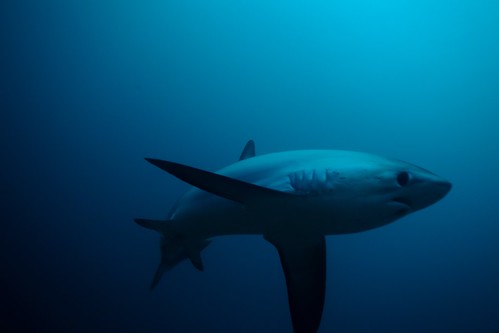
Leopard Shark. There are two species called “leopard shark”. A tropical species, Stegostoma fasciatum, and a temperate water houndshark, Triakis semifasciata. Ah, common names, always confusing! Scientific names are so much better. There is actually a chapter in “Sex, Drugs and Scuba Diving” about them. The leopard shark I have seen is the temperate water species, Triakis semifasciata, in San Diego. During the late summer, lots of them aggregate in a little bit more than chest-deep water for the sake of mating. Swimming in circles just above the sand, the Sandy Egan ocean lover can snorkel not too far from shore and see two or three of these sharks below himself at every moment. On a nice sunny day, the sunlight was playing on the waves, and the sand was stirred up by the rhythmic water movement. In-between were the leopard sharks, with their streamlined bodies and spotted skins. It was a real aesthetic pleasure to watch these fish cruise about.
Swell Shark. Another San Diego sighting: a small catshark, which can inflate itself with seawater to wedge itself into a crevice, to avoid predation. The famous Scripps Canyon off La Jolla features some of these.
Horn Shark. A shark with horns on its dorsal fins. Sometimes seen in the San Diego sand.
Grey Nurse Shark. Sydney’s most impressive shark species. There are a few spots along the coast of New South Wales (the Aussie state which Sydney is in) with aggregations of grey nurse sharks: Magic Point in Sydney, Broughton Island off Nelson Bay, and Southwest Rocks further north. These are very social sharks, and spend the days together in family groups. There is evidence for social hunting in grey nurse sharks, and incredibly sophisticated behavior normally only seen in mammals life wolfs. These sharks hunt during dusk and dawn, and simply chill during the day. They calmly swim in circles, or hover in place. The smaller, juvenile sharks seem genuinely curious about divers and often come quite close. At Magic Point, the sharks congregate around a small cave and divers can sit in the sand in front of the cave’s entrance and suck in the shark action until their air runs out.
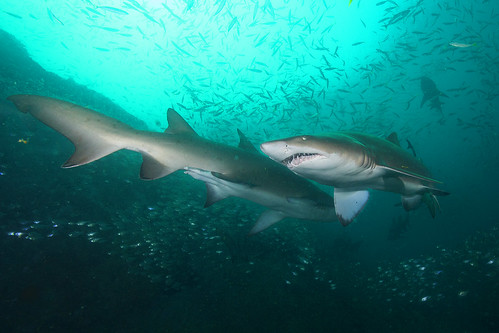
Spotted Wobbegong. A rather unusually shaped shark, with a flat head and lots of tassels around its mouth. Very stoic sharks, easy to photograph, they usually just lay on a rock. Despite their large size, definitely up to pro-wrestler-on-growth-hormone size, they are easy to overlook due to their camouflaged skin pattern and immobility. Common around Sydney, often also hiding under ledges. Oak Park in Cornulla is a good spot for wobbie-watching.
Ornate Wobbegong. Much rarer than the spotted wobby, I have only seen this shark in shallow waters in Nelson Bay, about three hours north of Sydney by car. It’s smaller and darker than the spotted wobbegong.

Blind Shark. Not actually blind, but with small eyes, this shark is a distant relative of the wobbegongs. I’ve seen blind sharks in shallow seagrass areas in Nelson Bay, Australia.
Port Jackson Shark. Another Australian east coast endemic (= only occurring here), like so much of the fish life found around Sydney. These horn sharks appear during the winter, when the water is colder, and often congregate in groups, huddling in crevices. At the end of the winter, the Sydney diver will observe lots of PJS egg shells. Seemingly they migrate further south in summer.
Crested Horn Shark. A small bottom living horn shark found in Sydney. The crested horn sharks occur less often in groups than the Port Jackson’s. Look at the mouth of the shark in the photograph below: in a very un-shark-like fashion, it does not have teeth. Rather, the crested horn and Port Jackson shark have solid plates they use to crush the shellfish and clams they feed on. What is the crested horn shark below munching on? A Port Jackson shark egg! Talk about a lack of shark-shark solidarity.
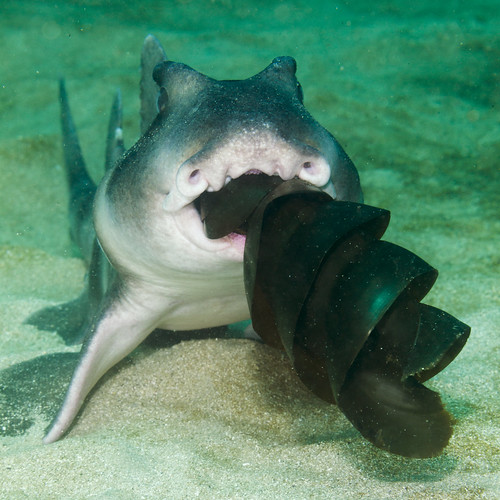
Are my raves about sharks interesting? Then join me at the Shark Conservation Specialty Course I teach with Abyss Scuba Diving in Sydney every month starting this May. And if you have developed a sudden urge to photograph thresher sharks, the Evolution Photoganza this September in the Philippines is a great opportunity for that. Plus, check out all of my shark pictures here.
